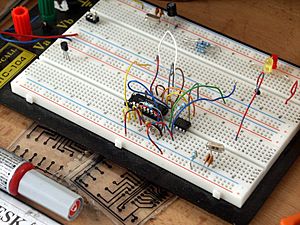Electrical circuit facts for kids
An electrical circuit is like a complete loop or path that tiny particles called electrons can travel through. These electrons come from a power source, like a battery or a wall outlet.
The place where electrons start their journey in a circuit is called the "source." The place where they finish and go back to the source is called the "return" or "earth ground." It's like a race track where the cars (electrons) start and end at the same spot.
The "load" is the part of the circuit that uses the electricity to do work. This could be something simple, like a refrigerator, a television, or a lamp in your home. Or it could be something much bigger, like the huge machines at a power plant that generate electricity.
Circuits use two main types of electrical power: alternating current (AC) and direct current (DC). AC is often used for large appliances and motors. It's the kind of power that comes from power stations to your home. DC powers things like battery-operated vehicles and many smaller electronic gadgets. Special devices called converters can change AC to DC, or DC to AC.
Contents
What is an Electronic Circuit?
Electronic circuits usually get their power from direct current (DC) sources, like batteries. The "load" in an electronic circuit can be quite simple. For example, it might be just a few resistors, capacitors, and a small lamp working together to create the flash in a camera.
But electronic circuits can also be very complex. They might connect thousands of resistors, capacitors, and transistors. A great example is an integrated circuit, like the microprocessor inside your computer. This tiny chip holds millions of tiny circuits!
Components like resistors can be connected in different ways. When they are connected "in series," it means they are lined up one after another. When they are connected "in parallel," they are side-by-side, offering multiple paths for the electricity.
How to Read a Circuit Diagram
A circuit diagram, also called a wiring diagram, is a visual map of an electrical circuit. Electrical and electronic circuits can be quite complicated. A drawing that shows how all the parts are connected makes it much easier to understand.
Drawings for electronic circuits are usually called "circuit diagrams." Drawings for electrical circuits are often called "wiring diagrams." These diagrams are typically drawn by draftsmen or created digitally using special computer software.
A schematic is a type of circuit diagram. It uses symbols to represent the different parts of the circuit. Schematics show the important connections, but they don't look exactly like the real circuit. They use standard symbols for things like resistors, capacitors, insulators, motors, and switches.
These diagrams are a huge help for engineers and technicians. They use them to design new circuits or to figure out why an existing circuit isn't working correctly.
Why We Need Circuit Breakers
Sometimes, the amount of electricity flowing in a circuit can suddenly become too high. This can happen if a part breaks or if there's a problem. Too much current can seriously damage other parts in the circuit. It can even cause a fire!
To prevent this danger, a fuse or a device called a "circuit breaker" is wired into the circuit. If the current gets too high, the circuit breaker will automatically "break" or open the circuit, stopping the flow of electricity. A fuse works similarly, but it "blows" (melts) and needs to be replaced. These devices act like safety guards for your electrical systems.
Ground-Fault-Interrupt (GFI) Devices
The normal path for electricity to return to its source is through the "earth ground." But what if an electrical device breaks and this return path is cut off? If you touch the device, your body could accidentally become the new path for the electricity!
When your body becomes part of an electrical circuit, you can get a serious electric shock. In some cases, this can even be deadly.
To prevent this dangerous situation, we use special devices called Ground-Fault-Interrupt (GFI) devices. These devices are like super-fast detectors. They sense if the normal path to earth ground is broken. If they detect a problem, they immediately cut off the power to the device. GFI devices are similar to circuit breakers, but their main job is to protect people from electric shock, not just the circuit components. You often find them in bathrooms, kitchens, and outdoor outlets.
What is a Short Circuit?
A short circuit happens when electricity finds a shortcut back to its power source. Instead of flowing through the "load" (the part that uses the electricity), it takes a much shorter, unintended path. This usually means the electricity doesn't do any work, or it returns with almost the same power it started with.
Short circuits can cause a sudden surge of current. This often makes a fuse blow or a circuit breaker trip, which is a good thing because it protects the circuit. However, if there's no protection, a short circuit can be very dangerous. For example, if you cause a short circuit with a battery, it can get very hot and even start an electrical fire.
See also
 In Spanish: Circuito para niños
In Spanish: Circuito para niños


